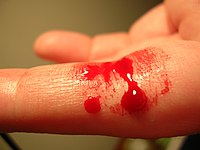
Photo from wikipedia
In patients with acute gastrointestinal bleeding, it is critical to clear away blood clots for subsequent hemostasis during endoscopy, and unsuccessful elimination might be one reason for unsuccessful hemostasis in… Click to show full abstract
In patients with acute gastrointestinal bleeding, it is critical to clear away blood clots for subsequent hemostasis during endoscopy, and unsuccessful elimination might be one reason for unsuccessful hemostasis in urgent endoscopy [1]. We reported the utility of an external cannula to improve endoscopy preparation for a patient with gastroesophageal anastomotic stenosis [2]. Here we show how to apply this modified external cannula to facilitate hemostasis. The patient with lower gastrointestinal bleeding was a 72-year-old man with a history of radiation proctitis due to prostate cancer who complained of persistent hematochezia. Examination by sigmoidoscope showed blood clots blocking the rectal lumen. The patient with upper gastrointestinal bleeding was a 31-year-old man with hematemesis for 6 hours with a diagnosis of decompensated cirrhosis. Esophagogastroduodenoscopy showed esophageal varices and huge clots in the gastrointestinal tract. We successfully eliminated the refractory clots using the following procedure (▶Fig. 1,▶Video 1). We first shortened the external cannula (ST-SB1, Olympus) to 50 cm and prepared it with side apertures.We then prepared a suction tube (inner diameter of 8.0mm) with a control pore, which needed to be 55 cm from the head end. We inserted the cannula into the clots and engaged the suction tube to eliminate the clots. The scope was then inserted to confirm the effect and if clots remained, we repositioned the cannula and poured water into it to facilitate further elimination. When all the clots were cleared, we found a rectal ulcer with active bleeding in the patient with lower gastrointestinal bleeding (▶Fig. 2). In the patient with upper gastrointestinal bleeding, esophageal variceal bleeding was confirmed and ligated; meanwhile, the cannula did not exacerbate the variceal bleeding (▶Fig. 3). In conclusion, this modified device could easily clear blood clots, and in our experia
Journal Title: Endoscopy
Year Published: 2022
Link to full text (if available)
Share on Social Media: Sign Up to like & get
recommendations!